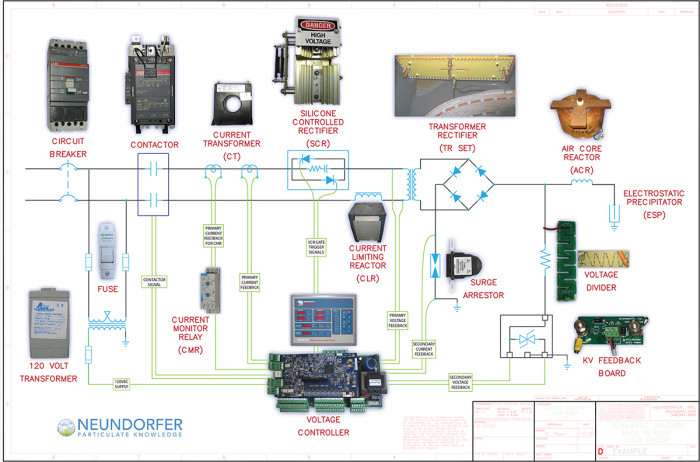Precipitator Control Systems
For more than 30 years Neundorfer has designed control systems for air pollution control equipment applications. Historically, the control systems offered were built around improving precipitator performance. This focus gradually broadened out to include control systems for flue gas conditioning systems, hopper evacuation systems on precipitators and baghouses, soot blowing systems, and sorbent injection systems. We have been able to adapt our existing systems to new applications, and design new systems, to meet customer challenges across the plant.
Voltage Controls
Precipitator performance and reliability is heavily influenced by the powering system. For conventional T/R sets, this also means that the voltage control can have a large impact on how it reacts to process variations, sparking, and ash chemistry, as well as how it maintains maximum voltage and current during operations. On top of the improved performance, the MVC-4 offers reliable data that can be used for troubleshooting, making condition based maintenance decisions, and optimization of how the equipment functions.
Since the late Seventies, we have been continuously refining the microprocessor-based automatic voltage control for electrostatic precipitators. The MVC-4 is the latest generation of this control. The MVC-4 controls standard T/R sets and has been proven to be easy to implement, cost-effective, and reliable. The MVC-4 has also drastically improved safety, and reliability, due to its self-calibrating capabilities meaning you don’t need to work on the control with the cabinet door open (OSHA Arc Flash Compliance).
Rapper Controls
Rapping is an essential component of precipitator performance. Rapping can be attributed to upwards of 30% of the baseline emissions at a plant. And with recent compliance requirements shrinking the operating margin of plants, this is margin that we can’t sacrifice. When you combine these tight operating margins with load swings and fuel changes, real-time rapping adjustments can make a huge impact on opacity and emissions compliance. You need a rapper control that is robust enough to provide you with the ability to optimize rapping with changing conditions and keep emissions low. We have one.
Our Microprocessor-based control, MicroRap, offers more programming flexibility and reliability than any other rapper control. It meets the needs of our customers because it was designed, refined, and programmed by engineers with extensive knowledge of precipitator performance. Combined with our software system, you have a rapper control than can adapt to various process inputs, load, performance indicators, and control feedback. In the end, you get a rapper control that will help you lower outlet emissions and adapt to process changes over time.
PLC Applications
Our PLC programmers have firsthand knowledge of the control applications which improves the quality of the design, the quality of the documentation you receive, your experience, and the performance of the equipment it is controlling. We have experience with many different PLC brand controllers across applications such as precipitator rapper controls, baghouse cleaning, sorbent injection systems, hopper evacuation systems, and SCR cleaning.
Files & Resources
- Page
- Justifying Controls with Opacity-Driven Energy Optimization
- View Page
- Page
- Waste-to-Energy Upgrades Yield Dramatic Improvements
- View Page
- Page
- Baghouse Integration Dramatically Reduces O&M Costs
- View Page
- Voltage Control Schematic
- View Document
- MVC 4 Feature Sheet
- View Document
- MVC 4 User Manual
- View Document
- MVC 3 User Manual
- View Document
- MVC 3 to 4 Conversion
- View Document
- MicroRap Feature Sheet
- View Document
- MicroRap User Manual
- View Document



